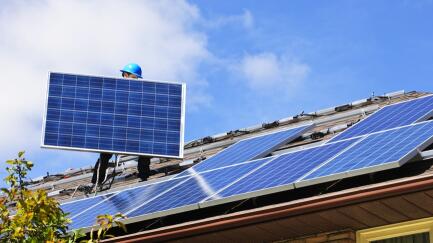With no end in sight for an electricity crunch that has lasted for more than a decade, South Africans are looking at alternative sources of energy, and solar is top of the list.
FOR MORE than a decade, South Africa’s power supply has been erratic, with state utility Eskom forced to implement load shedding on and off to avoid overwhelming the grid.
This has put immense pressure on the energy-reliant economy, in addition to undermining the quality of life for households.
With no end in sight for the electricity crunch, South Africans are looking at alternative sources of energy, and solar is top of the list.
Consumers have two main options when considering solar energy — a ‘hybrid’ or ‘off the grid’ set-up, according to Neil Berrow, the director of Solar Advice, one of South Africa’s leading solar power suppliers.
Running a hybrid set-up offers far more value for money for the average consumer, Berrow recommended on Monday.
Hybrid Set-up
Some of the benefits:
- If you deplete your solar battery, you have Eskom electricity as a back-up.
- If you deplete your solar battery, you have Eskom electricity as a back-up.
Hybrid inverters blend DC and AC energy, making use of the solar first, then blending battery power to make up the load and blending any additional power from Eskom. This is far more efficient than off-grid inverters.
To run a hybrid system, with the consumer paying on average R1,500 (R2.20 pKw) per month, requires:
- If you deplete your solar battery, you have Eskom electricity as a back-up.
- If you deplete your solar battery, you have Eskom electricity as a back-up.
Total cost for the Hybrid set-up is R155,576.88 including value-added tax (VAT).
“This system will cover the load and have enough to charge the batteries,” said Berrow.
The bank is 9.6kWh, which is rounded to 7.7kWh available, covering lower-rated appliances throughout the evening, night and morning (if the consumer has a solar geyser and gas stove).
The return on investment and savings over a 10-year period with a hybrid set-up is greater than the off-grid, Berrow added.
For fed-up consumers who want to completely cut Eskom off, the off-grid route is a viable option, although the costs are higher as a larger battery back-up is required.
Off the grid
Running a set-up completely off-grid (for consumers with a solar geyser and gas stove):
- If you deplete your solar battery, you have Eskom electricity as a back-up.
A householder paying around R1,500 (R 2.20 per kWh) per month will need:
- If you deplete your solar battery, you have Eskom electricity as a back-up.
- If you deplete your solar battery, you have Eskom electricity as a back-up.
“This battery is 80 percent DOD (depth of discharge). Because (of that) you would need to add another 20 percent battery on top to make the full 24kWh, so it will be 4.4kWh over to make up for that,” Berrow said, referring to the battery power outage.
The total cost for the off-grid set up is R354,583.40 including VAT.
To reduce the cost of this set-up, consumers can cut down on electricity consumption in the evenings and on cloudy days, said Berrow.
“It will take longer to get a return on investment because of the large backup battery bank, although you would save in the long run. Using Eskom as a back-up makes more financial sense.”








